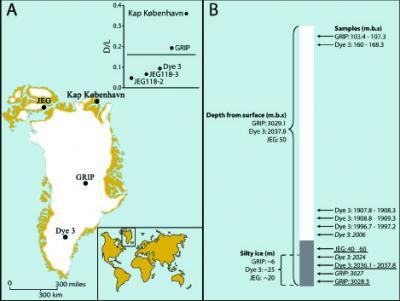A team of international researchers has collected the oldest ever recovered DNA samples and used them to show that Greenland was much warmer at some point during the last Ice Age than most people have believed. Their findings also confirm that the whole ice sheet will not melt and bring about the tremendous sea-level rises which have been the subject of so much discussion.
The ancient DNA was discovered at the bottom of a two kilometer thick ice sheet and came from the trees, plants and insects of a boreal forest estimated to be between 450,000 and 900,000 years-old. Previously, the youngest evidence of a boreal forest in Greenland was from 2.4 million years ago. Greenland, Dye 3 Icecore drilling project. Credit: Martin Bay Hebsgaard, University of Copenhagen
Greenland, Dye 3 Icecore drilling project. Credit: Martin Bay Hebsgaard, University of Copenhagen
The research results are the first direct proof that there was forest in southern Greenland, says Eske Willerslev, a professor at Copenhagen University. Willerslev found genetic traces of insects such as butterflies, moths, flies and beetles. But when was that" According to most scientific theories to date, all of southern Greenland and most of the northern part were ice-free during the last interglacial period 125,000 years ago, when the climate was 5 degrees warmer than the interglacial period we currently live in.
That signifies that there was ice there during the Eemian interglacial period 125,000 years ago.
"These findings allow us to make a more accurate environmental reconstruction of the time period from which these samples were taken, and what we've learned is that this part of the world was significantly warmer than most people thought," said Martin Sharp, a glaciologist at the University of Alberta and a co-author of the paper.
The ice-core researchers are experts at analysing the fine dust which blows onto the ice and is preserved year by year. They advocate two further datings. One is dating by optically stimulated luminescence. It is a method where the examined minerals can be affected to give off a type of light, which depends on how long it has been since the minerals were last exposed to sunlight.
The other method is radioactive dating. “We can fix when the ice was last in contact with the atmosphere,” says Jørgen Peder Steffensen who is a researcher in the Ice and Climate group at the Niles Bohr Institute at Copenhagen University. He explains that the special isotopes, Beryllium-10 and Chlorine-36 both have a particular half-life of radioactive decay (just like Carbon-14). The relation between them can date when the ice and dust were buried and no longer came in contact with the atmosphere.
The dating of dust particles also showed that it has been at least 450,000 years ago since the area of the DYE-3 drilling, in the southern part of Greenland, was ice-free.
Sharp said the silty ice found underneath the huge Greenland glacier created a perfect, natural "freezer" to preserve the prehistoric DNA. Scientists have, in the past, found older organic matter, but they have not found any uncontaminated DNA that is as old or older than the Greenland samples.
Sharp and his PhD student Joel Barker contributed to the research by providing DNA samples from the silty ice of much younger glaciers (3,000 years-old) on Ellesmere Island in Arctic Canada. The Canadian DNA samples offered a control sample for the researchers around the world who worked to estimate the age of the Greenland DNA samples.
The work in Canada also contributed to the evidence that suggests the boreal forest DNA samples found in Greenland were from forests that grew where the samples were found and were not from plant matter carried by wind or water from forests elsewhere in the world.
The DNA samples suggest the temperature of the southern Greenland boreal forests 450,000 to 900,000 years-ago was probably between 10C in summer and -17C in winter. Also, the reduced glacier cover in that region means the global ocean was probably between one and two metres higher during that time compared to current levels.
Sharp, who has been a supporter of the idea that the current global warming trend is human induced, believes the new research offers evidence that climate warming on the current scale is possible through natural conditions.
However, he cautions that this research does not prove the current global warming trend is not human induced.
"It could mean that our current warming is the result of both natural processes and human influences, and we may be heading for even bigger temperature increases than we previously thought," Sharp said.
Sources: University of Alberta and University of Copenhagen